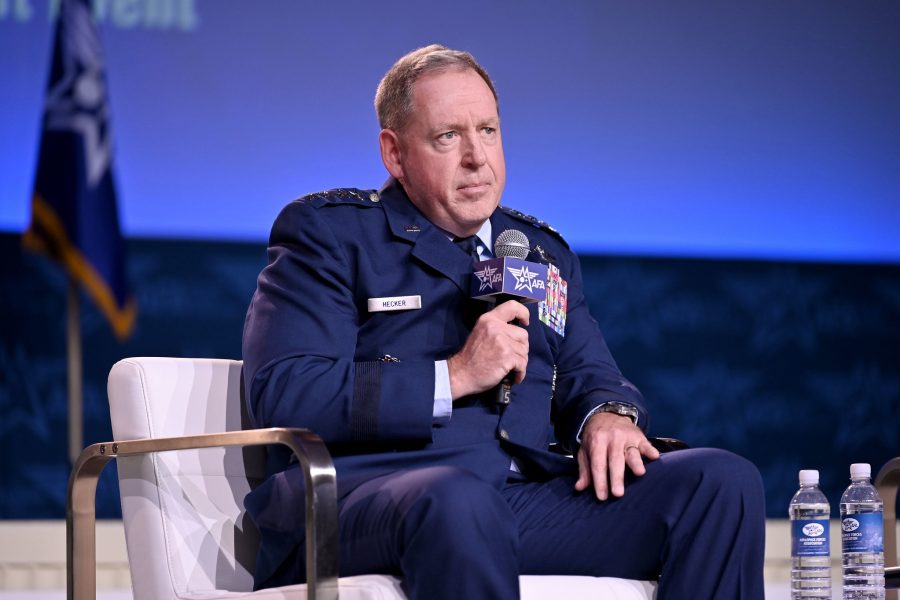NATIONAL HARBOR, Md.—Ukraine is taking a cautious approach toward employing its new F-16s, the top U.S. Air Force officer in Europe said Sept. 17.
“The pilots are new to it, so they’re not going to put them at the riskiest missions,” Gen. James B. Hecker, the head of U.S. Air Forces in Europe and NATO Allied Air Command, told reporters Sept. 17 at AFA’s Air, Space & Cyber conference. “Ultimately, that’s a Ukrainian decision. But I think that’s the approach that they’re taking.”
Ukraine first began flying the F-16 in August, and the aircraft has already proved successful in shooting down Russian cruise missiles and drones. But in one missile and drone barrage, a Ukrainian F-16 crashed, killing its pilot. Ukraine is investigating the incident.
Ukraine’s Air Force commander was fired soon after. Hecker said the U.S. has offered its assistance, but the U.S. had yet to “see if they take us up on that offer.”
The U.S. has not only trained Ukrainian pilots and maintainers but is also trying to boost the status of the country’s air force within the Ukrainian military.
“In a lot of the former Soviet Union countries, the army was kind of the service, and everybody else was below that and maybe didn’t get a voice at the table,” Hecker said. “So I have been asking that the Air Force get positions on the General Staff.”
The goal, which Hecker said is backed by U.S. Army Gen. Christopher G. Cavoli, the head of U.S. European Command and the NATO Supreme Allied Commander, is to enable Ukraine’s air force to do more joint operations with the country’s ground forces.
Despite doubts that Ukraine would be able to maintain the jets, Hecker said Ukrainian maintainers are succeeding. “We’ve trained a lot of Ukrainian maintainers, and from all accounts, when I talk to the instructors that are training them, they catch on very quickly,” Hecker said. “I know they’re flying. That’s good news.”
The Biden administration has shelved a proposal to hire American civilian contractors to help maintain the aircraft, hoping instead that contractors from European nations will assume some of that responsibility.
Meanwhile, Ukrainian F-16s are likely to be employed mainly in an air defense role as its air force develops the skills and understanding to leverage all its capabilities.
To date in the war, Ukraine has shot down more than 100 Russian aircraft, Hecker said, and Russia has shot down at least 75 Ukrainian aircraft. That’s kept both sides from fully employing its fighters for fear of losing them.
“What we see is the aircraft are kind of staying on their own side of the line, if you will,” Hecker said.
“What none of us probably forecasted is that nobody would get air superiority, neither Ukraine or Russia,” he said. “And now it’s been two and a half years, and neither one has, and that’s because of the integrated air and missile defense systems that both of them have.”
Russia is continuing to field glide bombs, ballistic and cruise missiles, and drones, increasing the air defense mission for Ukraine. In addition, Russian President Vladimir Putin recently ordered an increase in Russia’s military to some 1.5 million troops. “Russia is getting larger, and they’re getting better than they were before,” Hecker said.
Ukraine has been promised at least 80 F-16s, with the first aircraft coming from Denmark, the Netherlands, Belgium, and Norway. On Sept. 17. Ukrainian President Volomyr Zelenskky said the country had a new “ambitious” strategy to “increase the number of combat aircraft in Ukraine and speed up our pilot training.”
U.S. and Denmark are leading the training, but the U.K. and others are also training pilots on Western tactics in jet aircraft. There are over a dozen countries in the Ukraine Defense Contact Group’s Air Force Capability Coalition, co-led by Denmark, the Netherlands, and the United States. That group is “advising Ukraine and providing training, funding, aircraft, and critical equipment” to build up a fouth-generation fighter force, according to U.S. Navy Lt. Cmdr. Javan Rasnake, a Pentagon spokesperson. After a Sept. 6 meeting of the Ukraine Defense Contact Group, Canada said it would train new pilots without previous flight experience. The Ukrainian pilots training in the U.S. and Denmark have previous experience flying Soviet-era combat aircraft.
“We can’t train them fast enough,” Hecker said. “The good news is we have a coalition that is helping with the training.”


